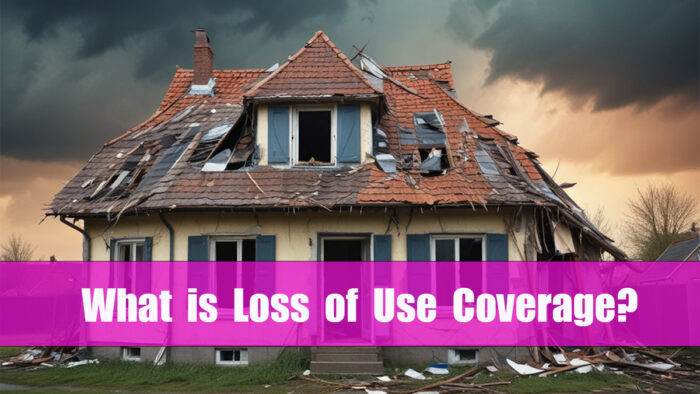Obtaining the best home insurance policy that includes loss-of-use coverage can help ease financial stress and other expenses. Loss of use coverage offers protection to policyholders in a situation where they are compelled to move into another house as a result of damage done to their home.

Individuals can refer to their loss of use coverage when there is severe damage incurred in their home and they need temporary accommodation until the repairs are done.
If you seek further information, read to the end of this article. We will be providing comprehensive information on what loss of use coverage entails, exploring what it covers and its limitations, as well as other tips that would add to your knowledge about this type of insurance.
What Is Loss of Use Coverage?
Loss of use coverage, sometimes called additional living expenses coverage, is a type of coverage under home insurance that helps to pay for bills and additional housing costs when your home is inhabitable as a result of one form of damage or another.
Usually, it is added when purchasing homeowners or renters insurance. So, if you obtain any of this insurance, you are eligible to enjoy the benefits it offers.
What Does It Cover?
There are lots of expenses that loss of use coverage provides reimbursement for; it offers coverage for:
- Laundry service.
- Storage
- Grocery and restaurant bills.
- Pet boarding for policyholders whose temporary house does not accept pets.
- Moving costs to get back into your house after the damage has been sorted out.
- Temporary Housing
- Mileage in a situation where your temporary home is far away from work.
- Mileage for places you may visit for rebuilding purposes, such as furniture or flooring stores.
Beyond the aforementioned coverage, it also reimburses you for other expenses incurred in your home, provided they are covered by your insurance policy.
It is important to note that loss of use coverage will only reimburse you for the expenses incurred based on your previous standard of living. If you once lived in a three-bedroom house and moved temporarily into a six-bedroom house, you will not be reimbursed.
What Does It Not Cover?
While this insurance coverage offers protection for a variety of losses and damages, there are certain things it does not cover. They include payment for:
- Your food.
- Mortgage payments.
- Child care costs.
- Housing expenses
It will also not cover other related costs, for instance, if your home is not damaged and you live elsewhere because of an extended power outage.
When Should I File a Claim for Loss of Use Coverage?
There are certain situations and severe damage that may warrant you filing a claim for additional living expenses. These include:
- Vandalism
- Wind damage
- Explosion
- Falling objects.
- Damage caused by snow, ice, or sleet.
- Fire
These are situations when you can refer to your loss-of-use coverage. You can also file a claim when you are mandated to evacuate your home by civil authorities, even when there is no damage done to your home.
How to File a Claim for Loss of Use Coverage
When filing a claim for loss of use coverage, there are certain steps you need to take. If there’s a situation that warrants you referring to your loss of use coverage, follow the tips highlighted below:
• Understand what your loss of use covers and its exclusions
One of the major things to consider when filing a claim for loss of use coverage is to understand what it covers and what it does not. This would enable you to make informed decisions that would ultimately prevent you from going beyond what your insurance policy has provided.
• Request for a cash advance
If you are unable to afford the payment of certain expenses, the next thing to do when filing a claim is to ask your insurance provider for a cash advance. Your insurance company may offer you a cash advance in order to cater for extra expenses, such as clothing and housing.
• Ask your insurance provider to help with housing
If there’s an immediate need for accommodation, you should ask for coverage from your insurance provider. Several insurance companies collaborate with vendors who supply housing for claims of additional living expenses. So, you can request house rentals or hotel accommodations.
• Save receipts
For any expenses you cover out of your pockets that fall under your loss of use coverage, ensure to keep all receipts because you will be required to provide proof of payments when filing for a claim.
It is important to note that the money from your loss of use coverage will not be used for a different part of the claim, like a claim for personal property damage or the like.
FAQs
What is the difference between loss of use and additional living expenses?
Well, there’s no difference between loss of use and additional living expense coverage. The two words are used to mean the same type of insurance. Thus, they can be used interchangeably. Most often than not, loss of use and additional living expenses coverage are also referred to as Coverage D.
What is loss of use coverage for renters insurance?
In renters insurance, policyholders can refer to their loss of use coverage if there are situations where the rented room or apartment is severely damaged and unsafe to stay in. The majority of renters insurance policies provide coverage for damages done to the renters apartment.
Is there a deductible with loss of use coverage?
In a home insurance policy, there’s no deductible if you file a claim for additional living expenses. However, there’s a tendency to have homeowners insurance deductible for the damage caused to the home.
There are situations that may deem you fit for a deductible in some parts of your claim. Ensure you seek clarity from your insurance provider to get a better understanding of the coverage and exclusions.


